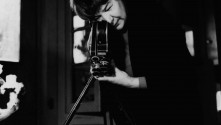




Of Light and Lightness
The Films of Marie Menken
The realist sees only the front of a building, the outlines, a street, a tree. Marie Menken sees in them the motion of time and eye. She sees the motions of heart in a tree. ... A rain that she sees, a tender rain, becomes the memory of all rains she ever saw; a garden that she sees becomes a memory of all gardens, all color, all perfume, all mid-summer and sun.
Marie Menken (1910-1970) is the unsung heroine of the American avant-garde cinema. A mentor, muse and major influence for such key experimental filmmakers as Kenneth Anger, Stan Brakhage, Jonas Mekas and Andy Warhol, Menken created an extraordinary body of exuberant and stunningly beautiful films shaped, above all, by her intuitive understanding of handheld cinematography. Beginning with her celebrated first film, Visual Variations on Noguchi (1945), Menken used the hand-cranked Bolex camerafavored by avant-garde filmmakers to introduce a new agility, grace and spontaneity into experimental cinema, a lightness of camera and form hitherto unseen in American film. With Noguchi, Menken also began a spirited dialogue between cinema and the plastic and painterly arts that extends across her films in a witty yet deeply insightful exploration of the formal language and methodology specific to those schools and painters with whom Menken was close – from the Abstract Expressionist drip painting humorously critiqued in Drips in Strips (1963), to the factory production of Pop art in the revelatory Andy Warhol (1964) and the Fluxus practice of Robert Watts in Watts with Eggs (1967).
The longtime creative and marital partner of poet-filmmaker Willard Maas, Menken began as an accomplished painter whose eccentrically textured and effulgent canvases incorporate all manner of reflective media – phosphorescent paint, crushed glass, sequins – in a playful challenge to the traditional boundaries of the painted canvas. Light remained a major focus of Menken's films, most notably in major works such as Notebook (1940-62) and Lights (1964-66) which transform her Bolex into an instrument for painting marvelous sculptural forms from neon and city lights. Like the painters-turned-filmmakers Robert Breer and Carmen D'Avino, Menken (who animated the chess sequence in Maya Deren's At Land) embraced various animation techniques – collage, stop-motion cinematography – as a direct extension of her painting. Yet for Menken, animation also became a way of radically transforming the world around her, reimagining postwar New York City, for example, in her masterpiece of single frame cinematography Go! Go! Go! (1962-64), a work that condenses two years of patient documentary filmmaking into a delirious and exhilarating vision of a hyperactive city.
An important first step towards the recuperation of Menken as a major artist and figure in the postwar avant-garde scene, Martina Kudláček’s recent documentary Notes on Marie Menken (2006) includes rare footage and revealing interviews with a number of close friends and colleagues such as Anger, Mekas, Gerard Malanga and Alfred Leslie. We are pleased to include the rarely seen films Zenscapes and The Gravediggers From Guadix both recently preserved by Anthology Film Archives, who we graciously thank for their permission to screen these titles.






